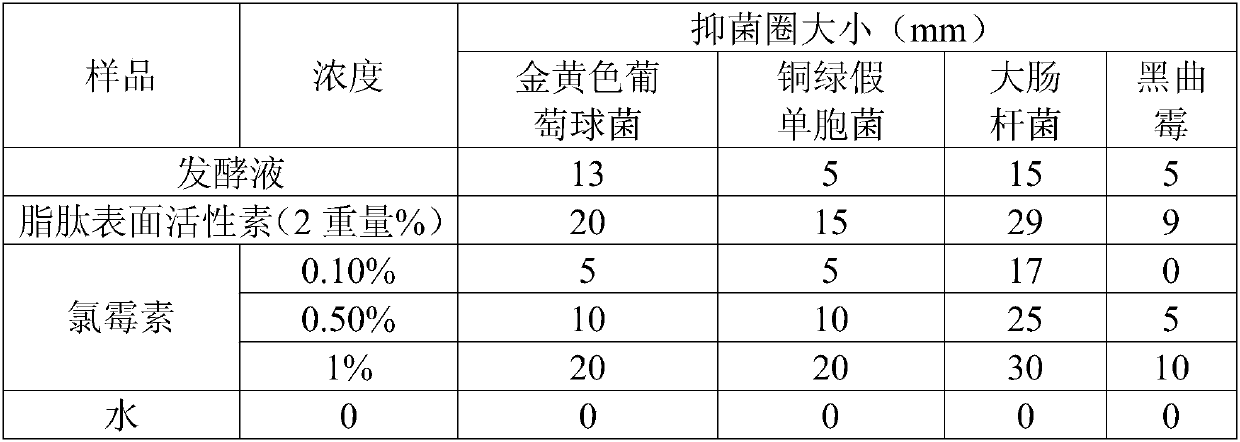Application of Sporosarcina koreensis CGMCC No. 5915, preparation method of lipopeptide surfactins and composition of Sporosarcina koreensis
A sporococcus spore and surfactin technology, applied in the field of microorganisms, can solve the problems of limited surfactin application, low surfactin yield and high production cost, and achieve the effects of maintaining soil moisture, uniform fertilizer, and uniform dispersion
- Summary
- Abstract
- Description
- Claims
- Application Information
AI Technical Summary
Problems solved by technology
Method used
Image
Examples
Embodiment approach
[0045] According to a specific embodiment of the present invention, the pesticide is chlorothalonil.
[0046] 3) Application of Sporosarcina koreansis with preservation number CGMCC No.5915 in antibacterial, antiviral and agricultural pest inhibition.
[0047] Wherein, the bacteria may be various bacteria, for example, but not limited to Escherichia coli, Staphylococcus aureus, Streptococcus thermophilus, Pseudomonas aeruginosa, Aspergillus niger and the like. And according to its non-toxic properties, the Korean bacillus sarcini (Sporosarcina koreansis) with the preservation number CGMCC No.5915 can also be applied in food as a preservative.
[0048] The virus may be, but not limited to, TMEV (Turrell Murine Encephalomyelitis Virus), HSV-1 (Herpes Simplex Virus-1) and HSV-2 (Herpes Simplex Virus-2), HIV and the like.
[0049] The agricultural pests may be rice planthopper, powdery mildew, corn borer, cotton bollworm, wheat rust, cotton aphid, rice sheath blight, rice blast, ...
Embodiment 1
[0075] Preparation method and identification of lipopeptide surfactin produced by Sporosarcina koreensis
[0076] (1) Preparation of Surfactin
[0077] A single colony of Sporosarcina koreensis was dissolved in a fermentation medium (LB liquid medium: 5 g of yeast extract powder, 10 g of tryptone, and 10 g of sodium chloride) at 37° C., added with distilled water and stirred to dissolve, and mixed with 5 mol / L Adjust the pH to about 7.2 with NaOH, adjust the volume to 1000ml with distilled water, sterilize at 121°C for 20min) and ferment and cultivate for 48 hours to obtain the fermentation broth.
[0078] The fermentation broth was centrifuged at 10000rpm for 25min to remove the precipitate and collect the supernatant. Then add hydrochloric acid with a concentration of 6 mol / L to the collected supernatant, stir with a glass rod to make it evenly mixed, and adjust the pH of the supernatant to about 2.0. Then put it in a refrigerator at 4°C overnight, centrifuge at 10,000 rpm...
Embodiment 2
[0091] This example is used to illustrate the analysis of the surface activity of the oil drainage circle of the fermentation broth
[0092] Add 1 g of Sudan Red III to 300 mL of liquid paraffin, stir and mix evenly with a glass rod, and filter under reduced pressure with a vacuum pump to remove insoluble impurities. Take 25mL of liquid paraffin stained with Sudan Red III and pour it into a petri dish with a diameter of about 9cm. After the whole petri dish is covered with liquid paraffin, slowly add 1 mL of Surfactin (2%) produced by Sporosarcina koreansis, 1 mL of 0.1% sodium lauryl sulfate solution, and 1 mL of standard Surfactin (Surfactin, brand name Sigma) at a concentration of 0.5 mg / mL -Aldrich, product number S3523) solution, measure the diameter of the oil drainage ring with a ruler and take a picture to record it, add 1mL of blank methanol to the center of the petri dish as a blank control, and repeat the experiment of each material oil drainage ring three times, th...
PUM
 Login to View More
Login to View More Abstract
Description
Claims
Application Information
 Login to View More
Login to View More - R&D
- Intellectual Property
- Life Sciences
- Materials
- Tech Scout
- Unparalleled Data Quality
- Higher Quality Content
- 60% Fewer Hallucinations
Browse by: Latest US Patents, China's latest patents, Technical Efficacy Thesaurus, Application Domain, Technology Topic, Popular Technical Reports.
© 2025 PatSnap. All rights reserved.Legal|Privacy policy|Modern Slavery Act Transparency Statement|Sitemap|About US| Contact US: help@patsnap.com



